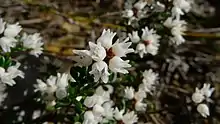Cryptandra amara
Cryptandra amara, commonly known as bitter cryptandra, is a shrub species in the family Rhamnaceae native to eastern Australia.[1]
| Cryptandra amara | |
|---|---|
 | |
| Scientific classification | |
| Kingdom: | Plantae |
| Clade: | Tracheophytes |
| Clade: | Angiosperms |
| Clade: | Eudicots |
| Clade: | Rosids |
| Order: | Rosales |
| Family: | Rhamnaceae |
| Genus: | Cryptandra |
| Species: | C. amara |
| Binomial name | |
| Cryptandra amara Sm. | |
Distribution and habitat
Cryptandra amara is found in Queensland, New South Wales, South Australia, Victoria and Tasmania.[2] It is found in extremely dry, rocky areas; and its habitat ranges from near-riverine rockplates to grasslands, grassy woodlands and healthy forests.[3][4]
Description
Cryptandra amara is a small woody shrub, and is upto 0.5-1 m high. It is often extensively branched, the branches tending to be rigid and covered in tiny hairs. The leaves, 2-6 mm long and roughly oblong in shape, are often clustered. White tubular flowers, usually 3-4 mm long, occur singly or clustered at the end of branchlets. Their bracts are broad and obtuse. The fruit of Cryptandra amara is a capsule, which divides into single-seeded fruitlets. The seeds are reddish-brown in colour, with a short aril.[5][6]
Cryptandra amara is easily recognized when it is flowering, although its distinct habit and foliage means it can be identified at any time of the year.[7]
References
- Harden, Gwen. "Cryptandra amara". Plant NET - New South Wales Flora Online. NSW Government. Retrieved 25 February 2016.
- "Cryptandra amara listing statement.doc". Archived from the original on 28 March 2017.
- "Cryptandra amara listing statement.doc". Archived from the original on 28 March 2017.
- "Cryptandra amara - Threatened Species Link". www.threatenedspecieslink.tas.gov.au. Retrieved 6 January 2022.
- "Cryptandra amara listing statement.doc". Archived from the original on 28 March 2017.
- "PlantNET - FloraOnline". plantnet.rbgsyd.nsw.gov.au. Retrieved 6 January 2022.
- "Cryptandra amara listing statement.doc". Archived from the original on 28 March 2017.